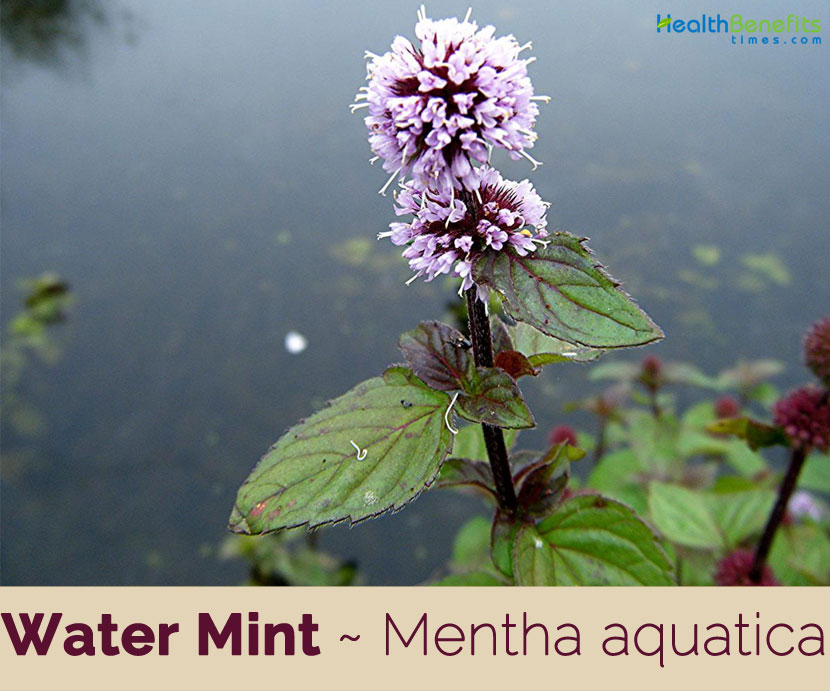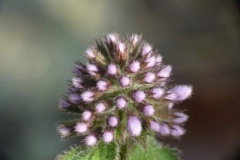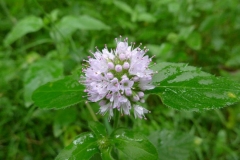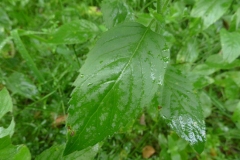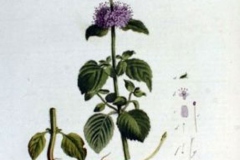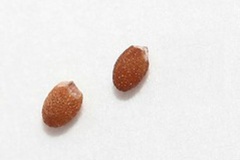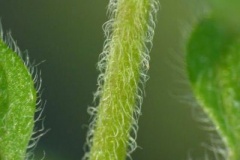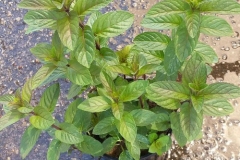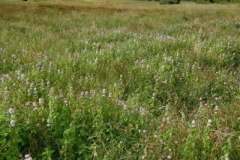Mentha, the generic name, comes from Greek mythology, in which the naiad Minthe (variably spelt also as Menthe, Mintha or Mentha) was transformed into a sweet-smelling mint plant by Persephone, daughter of Zeus and queen of the underworld. The specific epithet aquatica means, just as it sounds, aquatic – of water. Some historians believe that water mint is the mint referred to in Greek myth of Menthe, the nymph who was turned into the mint plant by jealous Persephone. They also believe that it is watermint that is used by Philemon and Baucis to scrub tables as mentioned in the writings of Ovid. Both the Greeks and the Romans used members of the mint family as a part of the ritual for preparing dead bodies to be interred. It was used for its aroma, which helped to mask the smell of decay. Water mint, are important for erosion control, food sources, animal habitat and simple waterline beauty.
Plant Description
Water mint is an herbaceous rhizomatous perennial flowering plant that grows about 90 centimeters (35 in) tall. As the name suggests, water mint occurs in the shallow margins and channels of streams, rivers, pools, dikes, ditches, canals, wet meadows, marshes and fens. If the plant grows in the water itself, it rises above the surface of the water. It generally occurs on mildly acidic to calcareous (it is common on soft limestone) mineral or peaty soils. It can occur in certain fen-meadow habitats such as the Juncus subnodulosus-Cirsium palustre plant association. Roots are fibrous and emerge from the rhizome. Stem is green or can have a purple color, are sometimes covered with hairs and have a four-sided shape. Like all mints, this plant spreads with long runners, which root at nodes and create daughter plants. It has the tendency to become invasive, so plant in a container to prevent invasive growth.
Leaves
Leaves are either oval or lance-shaped, grow in opposite pairs and have jagged edges. They can be 2 to 6 cm (0.79 to 2.36 in) long and 1 to 4 cm (0.39 to 1.57 in) wide, and just like the stems the color varies from green to purple and they can be sometimes hairy.
Flowers & Fruits
The flowers of the water mint are tiny, densely crowded, purple, tubular, and pinkish to lilac in color and form a terminal hemispherical inflorescence. Flowering takes place from July to October. Water mint is visited by many types of insects, and can be characterized by a generalized pollination syndrome, but can also spread by underground rhizomes. All parts of the plant have a distinctly minty smell. Fertile flowers are followed by 4-sectioned schizocarp. Mericarps are glossy–granular and yellowish brown.
- Leaves are anodyne, antiseptic, antispasmodic, astringent, carminative, cholagogue, diaphoretic, emetic, refrigerant, stimulant, stomachic, tonic and vasodilator.
- Tea made from the leaves has traditionally been used in the treatment of fevers, headaches, digestive disorders and various minor ailments.
- It is also used as a mouth-wash and a gargle for treating sore throats, ulcers, bad breath etc.
- Leaves are harvested as the plant comes into flower and can be dried for later use.
- Essential oil in the leaves is antiseptic, though it is toxic in large doses.
- It is used in herbal medicine in diarrhea and as an emmenogogue.
- It can be used in conjunction with stomach remedies and in difficult menstruation.
- Decoction of Water Mint prepared with vinegar is recommended to stop blood vomiting.
- Dried leaves tea aids in digestion and calms ulcers.
- Oils and aroma help relieve stuffy noses and clear the breathing passages.
- Water Mint makes a pleasant infusion and is useful for complaints of the digestive system – colic, constipation, diarrhea, nervous stomach etc.
- It helps to cleanse the liver and stimulate the appetite and circulation.
- Mild infusion taken at night is useful for its sedative effects and for deadening pain.
- Plant can cleanse open wounds and relax irritated muscles.
- Tea brewed using the dried leaves of water mint is good for digestion and can decrease the pain caused by ulcers.
- Water mint reduces head pain when ingested in crushed form, because of the very high content of vitamins A and E.
- The oil can stop the spread of skin diseases like eczema and eliminate acne, while reducing the unpleasant pain of insect bites.
- It can also prevent motion sickness.
- Water mint tea has many uses; it is a natural mouthwash effective against ulcers, nasty breath and infected throats but also treats digestive issues, fever or migraines.
Culinary Uses
- Leaves can be consumed raw or cooked.
- It is used as a flavoring in salads or cooked foods.
- Leaves are too pungent for most people to use as a flavoring.
- Herbal tea is made from the leaves.
- The oils in the leaves add flavor to cooking and baking and leaves add a bright zing to salads.
Other facts
- All parts of the plant have a distinctly minty smell.
- The plant repels flies, mice and rats.
- It has a pleasant, fresh scent and was formerly used as a strewing herb and has been strewn in granaries to keep mice and rats off the grain.
- The plant, harvested before flowering, yields about 0.8% essential oil.
- The fresh or dried plant is very good when used in herbal baths and can also be used in herb pillows.
- In Co Kerry it was smoked instead of tobacco.
- Water mint essential oil is a valued ingredient in cosmetics and can be found in some brands of toothpaste, mouthwash, after shave or shower gel.
- The scent can also improve cleaning products and adding some leaves to them will improve the air and the cleanliness of the house.
Precautions
- Large quantities of some members of this genus, especially when taken in the form of the extracted essential oil, can cause abortions so some caution is advised.
- It must be used in low amount during pregnancy.
- It is not recommended for infants.
References:
https://www.itis.gov/servlet/SingleRpt/SingleRpt?search_topic=TSN&search_value=32268#null
http://www.hear.org/pier/species/mentha_aquatica.htm
https://npgsweb.ars-grin.gov/gringlobal/taxonomydetail.aspx?id=24068
https://pfaf.org/user/Plant.aspx?LatinName=Mentha+aquatica
https://www.cabi.org/isc/datasheet/115568
http://www.floracatalana.net/mentha-aquatica-l-
https://botanical.com/botanical/mgmh/m/mints-39.html#wil
https://plants.usda.gov/core/profile?symbol=MEAQ
https://nas.er.usgs.gov/queries/FactSheet.aspx?SpeciesID=2668
https://nas.er.usgs.gov/queries/GreatLakes/FactSheet.aspx?SpeciesID=2668
https://en.wikipedia.org/wiki/Mentha_aquatica
http://luirig.altervista.org/schedenam/fnam.php?taxon=Mentha+aquatica
http://www.maltawildplants.com/LABT/Mentha_aquatica.php
http://www.narc.gov.jo/gringlobal/taxonomydetail.aspx?id=463703
https://gobotany.nativeplanttrust.org/species/mentha/aquatica/
http://www.theplantlist.org/tpl1.1/record/kew-124366
https://gd.eppo.int/taxon/MENAQ
Comments
| Water Mint Quick Facts | |
|---|---|
| Name: | Water Mint |
| Scientific Name: | Mentha aquatica |
| Origin | Europe, northern Africa and western Asia |
| Colors | Yellowish brown |
| Shapes | 4-sectioned schizocarp |
| Taste | Bitter |
| Health benefits | Beneficial for fevers, headaches, digestive disorders, sore throats, ulcers, bad breath, difficult menstruation, migraine and stimulate the appetite |
| Name | Water Mint |
|---|---|
| Scientific Name | Mentha aquatica |
| Native | Europe, northern Africa and western Asia. It has been introduced to North and South America, Australia and some Atlantic islands |
| Common Names | Creeping mint, Marsh mint, Water mint, Wild mint, Wild water mint, Curled mint, Bergamot mint, lemon Mint, bishop’s wort, fish mint |
| Name in Other Languages | Afrikaans: Waterment Albanian: Mendra e ujit, mendër Arabic: Naenae mayiy (نعناع مائي) Bulgarian: Vodna menta (водна мента) Burmese: Budi nan, Pusi nan Catalan: Alfàbrega de pastor, Herba-sana d’aigua, Menta d’aigua, Menta de riu, albarsana, herba d’aigua, herba de lavanda, herba puçera, herba sana, herba sana borda, menta d’aigua, menta de riu, paupeley Croatian: Vodena metvica Czech: Máta vodní Danish: Vandmynte Dutch: Watermunt English: Creeping mint, Marsh mint, Water mint, Wild mint, Wild water mint, Curled mint, Bergamot mint, lemon Mint, bishop’s wort, fish mint Estonian: Vesimünt Finnish: Vesiminttu French: Baume d’eau, Menthe aquatique, Menthe blanche, baume de rivière, bonhomme de rivière, menthe rouge, menthe à grenouille, riolet German: Bachminze, Krotnkraut, Teichminze, Wasserminze, Wasser-Minze Hebrew: Na’na hammayim, נַענַע הַמַּיִם Hungarian: Vízi menta Italian: Menta acquaiola, Menta d’acqua, mentastro d’acqua Japanese: Numa hakka (ヌマハッカ), Menta akuatika (メンタ・ア クアティカ), Mensa akuatika (メンサ・アクアティカ), numa hakka Latvian: Udens mētra Lithuanian: Vandeninė mėta Maltese: Nagħniegħ selvaġġ Norwegian: Vassmynte Occitan: Baume de font, Pòrc Polish: Mięta nadwodna, Mięta wodna Portuguese: Citrate, falsa-erva-cidreira, hierbabuena-de-agua, hortela-de-agua, hortelã-da-ribeira, hortelã-da-água, hortelã-de-água, hortelã-dos-ribeiros, hortelã-mourisca, hortelã-pimenta-bastarda, menta-acuática, menta-crespa, menta-dos-rios, neveda-do-rio Romanian: Izma broaștei Russian: Myata vodnaya (Мята водная), myata vodyanaya (мята водяная) Serbian: Vodena nana (водена нана), konjski bosiljak (коњски босиљак) Slovak: Mäta vodná Slovene: Vodna meta Spanish: Azándar, Hierba buena acuática, Hierba morisca , Menta colorada, bergamota, mentha, sándalo de agua, Hierbabuena morisca, Menta acuática, almaro, hierba rizada, hierba sana, hierba santa, hierbabuena de agua, hierbabuena de las huertas, hierbabuena morisca, hierbabuena morisca de Jaraba, hierbabuena murciana, hierbabuena rizada, hortolona de perro, mastranzos de agua, menta acuática, menta de agua, menta de río, poleos, presta, sandalo, sándalo Colorado, sándalo de agua, sándalo de jardín, sándalo macho, sándalo real, té bravo, té de prado, té de río, té de vega, té moruno Swedish: Vattenmynta, Vesiminttu, Hästmynta Turkish: Su nanesi Ukrainian: m’yata vodyana (м’ята водяна) Vietnamese: Rau thơm |
| Plant Growth Habit | Herbaceous rhizomatous perennial flowering plant |
| Growing Climates | Swamps, fen, marshes, bogs, water courses, lake and river shores, streams and ponds, pools, dykes, ditches, canals, wet meadows, in wet woods, humid areas, with almost constant rainfall |
| Soil | Occurs on mildly acid to calcareous (it is common on soft limestone) mineral or peaty soils |
| Plant Size | 90 centimeters (35 in) tall |
| Root | Fibrous and emerge from the rhizome |
| Stem | Green or can have a purple color, are sometimes covered with hairs and have a four-sided shape |
| Leaf | Leaves are either oval or lance-shaped, grow in opposite pairs and have jagged edges. They can be 2 to 6 cm (0.79 to 2.36 in) long and 1 to 4 cm (0.39 to 1.57 in) wide, and just like the stems the color varies from green to purple and they can be sometimes hairy. |
| Flowering season | July to October |
| Flower | Tiny, densely crowded, purple, tubular, and pinkish to lilac in color |
| Fruit Shape & Size | 4-sectioned schizocarp. Mericarps glossy–granular |
| Fruit Color | Yellowish brown |
| Flavor/Aroma | Minty smell |
| Taste | Bitter |
| Plant Parts Used | Leaves, oil |
| Season | September to October |


